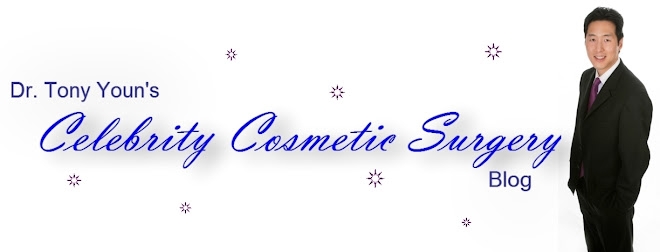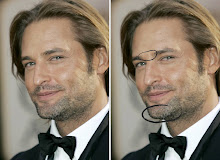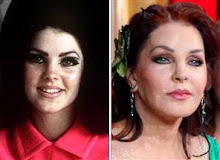Why is breast augmentation #1? Could it be:
Maybe it's because of people inspired by the woman who had a breast implant save her from the shrapnel of a Hizbollah rocket? Cool story, but I doubt it.
Could it be because of Jodie Marsh? God, no.
It's likely that the increasing number of women having breast augmentation is partially due to the strong economy (in everywhere but here in Michigan) and the fact that silicone gel implants were approved by the FDA in November. These implants are so superior to the saline implants in appearance and feel that I am now finding more women opting for these implants over saline implants, which are considerably less expensive and have been the standard in North America for 14 years (although outside North America are somewhat rarely used).
Back in 1992, when the silicone gel implants were banned by the FDA for widespread use, the ASPS reported only 32,600 breast augmentations performed for the year. This has now increased over 10-fold. Why is this? I believe one major factor is the vast improvement in quality of breast augmentation surgeries today. In the past, plastic surgeons often placed smaller, older style silicone gel implants on top of the muscle, using larger scars. This often created breasts which were hard, scarred, and unrealistic-appearing (sometimes as common as 70% of the time). The newer techniques utilize shorter scars and somewhat larger implants whch are often placed below the chest muscle. This usually creates a softer, more realistic breast.
With more and more silicone gel implants being used this year, I expect the numbers of breast augmentation surgeries to increase significantly from 2006 to 2007. We may see more and more celebrities having breast augmentation surgery as well, as the surgery continues to become more and more common.
For the ASPS statistics, visit plasticsurgery.org.
To view a video of breast augmentation I performed for Fox News, click here.
Thanks for reading.Michigan-based Plastic Surgeon
Anthony Youn, M.D.:











8 comments:
Doctor what do you think
of Adriana Sklenarikova?
Did she have as well a breast
augmentation?
Dr Youn - Just wondering how these stats measure up to your personal stats. Do you rate yours breast aug #1 lipo #2 and rhinoplasty #3 for your practice?
Tony,
I think the jury is still out on the over or under the muscle debate for implants with gel implants. There are a number of the talking heads in our field (Nahai, Tolbert Wilkinson, & Pat Maxwell, among others) who preferentially go over the muscle (Maxwell likes the subfascial position BTW). The ease of recovery and lack of animation from muscle contractures has really impressed me. The literture on capsules and reoperations sends a lot of mixed signals about whether there is in fact such a difference as was previously believed.
I'm still confused over the mixed messages I get from people whom are far more experienced then I over what looks more "natural". I think under the muscle is fine on people with no ptosis but you get a lot of "snoopy" deformities (implant high, breast tissue hang over low) on young droopy breast or with older women.
That being said, I've done 3 set this week all under the muscle because the two of the women were thin and one had breast cancer on the other side & I wanted to minimize mammogram interferance.
Anon- The surgery I perform most often is breast augmentation, followed by tummy tuck, then probably facelift or facial fat grafting. My numbers for breast augmentation are definitely up after the gel implants have been approved.
Rob- I do quite a few subglandular augmentations, and have found a slightly higher incidence of capsular contracture using this technique. I agree that neither above or below the muscle is ideal, and each has their positives and negatives. I think the problem of 'snoopy' deformities is best addressed by a 'dual-plane' type approach, where the pectoralis muscle is divided from the 5-7 o'clock position to allow the implant to settle subglandularly on the lower aspect. In patients with severe ptosis, a lift is needed if the implants are placed under the muscle, otherwise subglandular is a possibility (although not aesthetically ideal). Just my two cents...
Tony,
All dual plane augmentations will result in snoopy deformities of varying degrees when you follow them out long enough unless you get more then a little capsular contracture (which is about the only time that process is your friend). Submuscular implants stay higher and time/gravity march on on the breast tissue as it falls over the pec.
A little before your & my time, remember that almost all augmentations were subglandular gels. The real stimulus for moving to dual-plane positions was the upper pole rippling you got from salines which we were limited to in ~ 1990. As we get away from saline implants, I expect a lot more subglandular augmentations to be seen. Is it going to merely recreate past issues with capsular contracture? It's not clear whether that was related more to older thin wall & higher gel-bleed devices or to the change to more submuscular. placement.
If you more aggressively release the breast/pec interface (the dual plane
"2" or "3" as Tebbet's calls them) you can less of this, but you get progressively less muscle coverage of the implant. If I try to correct ptosis and feel the need to go submuscular, I've started to do this more and have been pleased with the early results. However, at some point the distinction between submuscular & subglandular gets blurred.
The subfascial position is what I do as opposed to true subglandular ones. It's intuitive to me that a highly vascularized tissue plane (like fascia, even when it's only 1-2mm thick) should have some protective effect if capsules are from infectious causes.
DO NOT!! try implanting breasts unless you know about the procedures and risks involved.
I prefer placing the implant over the muscle. I use round textured breast implant with great success.
My sister-in-law underwent a breast removal surgery after being diagnosed stage 2 borderline 3. Initial lumpectomy followed by bilateral mastectomy, 4 rounds chemo , oophorectomy, delayed reconstruction (tissue expanders replaced with saline implants), Arimidex. Can she now have a breast augmentation surgery without any on-time and future complications?
Post a Comment